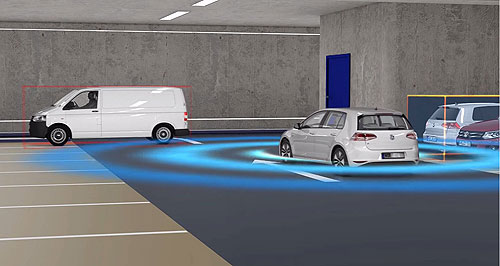Make / Model Search
News - VolkswagenCharge and park tech tested by VWVW expands park-assist tech with EV that finds its own car bay and recharges itselfGallery Click to see larger images 16 Jul 2015 By NEIL DOWLING VOLKSWAGEN is close to putting the valet out of work, with an electric car that will find its own charging bay, top up its batteries and then when fully charged, move to a conventional car parking area. And all without giving a tip. V-Charge, for valet charge, is a European Union project of Volkswagen AG and five other partners that aims to perfect autonomous parking as one major step towards the autonomous car. The concept was sparked by the growing number of motorists being delayed for appointments because they can not find a parking space for their car. V-Charge requires a tiered system involving a car with the ability to operate autonomously, a mobile-phone application and, preferably, a contained car-park structure such as a multi-story car park. Volkswagen said in a statement that there were many scenarios that highlight the advantages of V-Charge, including a commuter who is late for an important meting. “With V-Charge he is able to pull up right in front of the main entrance, get out and establish the link to his vehicle via the associated smartphone application,” Volkswagen said. “Operating fully automatically, the vehicle has a digital map relayed to it and within the parking area or multi-storey car park autonomously navigates to a parking space. “If it is an electric vehicle, the system additionally prioritises a parking bay with an automatic charging facility. Volkswagen says that cyclists, other vehicles and pedestrians are picked up by the vehicle's ultrasound sensors and cameras. The system determines whether the parking space is taken, thanks to the sensors and cameras, and if it is empty, the automated parking manouver kicks in to position the vehicle precisely above the charging spot. Once charged, the vehicle moves itself to another regualr parking space to ensure the charging station is free for use by other vehicles. When the driver returns to the car park, he or she calls the vehicle back to the starting point via the V-Charge app. Volkswagen said the technical prerequisites already exist, using current camera and sensor technology used in production cars for collision avoidance. In January this year the company showed a similar self-park system at the computer and electronics show, CES 2015, in Las Vegas. Called Trained Parking, it used existing technology on a petrol-fuelled Golf and allowed it to seek out and park in a carbay, then return to its owner. The V-Charge technology adds more autonomy and allows the electric car to recharge itself. The V-Charge test car, an electric e-Golf, uses four wide-angle cameras and two 3D cameras, 12 ultrasound sensors, digital maps and the 'Car2X' technology that communicates with the infrastructure, in this case a parking area. “Pedestrians, vehicles and obstacles get identified, parking spaces recognised and measured and then this stream of data is put together in real time to form an overall picture,” Volkswagen said in a statement. “The task that the technical 'sensory organs' have to fulfil is complex and extremely varied. “As continual tests run as part of the research project show, V-Charge is already functional today. “GPS-independent indoor localisation, centimetre-exact parking space measurement and 360-degree recognition of surroundings all function reliably, as do the system's reactions to pedestrians and vehicles and the way in which it takes account of traffic moving in line with or across the vehicle's path.” The partners in V-Charge include the Swiss Federal Institute of Technology (ETH) in Zurich which is responsible for visual localisation, movement planning and vehicle control, camera calibration and 3D reconstruction from images and obstacle detection. BraunschweigTechnical University works on the issues of car-park management and the vehicle's communication with the technical surroundings Robert Bosch GmbH contributes its expertise in the field of sensor technology Parma University looks after object recognition and Oxford University handles the development of detailed navigation maps of the parking area. As the sixth partner in the consortium, Volkswagen is providing the platform equipment, safety and control modules, as well as systems for static monitoring of surroundings, object recognition and automated parking. It’s hardly the first time Volkswagen has worked in automated vehicles and self-parking technology. In 2005, Volkswagen and the Stanford University in the US developed a Touareg – dubbed Stanley – that could operate autonomously. It followed that in 2007 with a Passat known as Junior that could find its way around a city’s central business district. Then 'Paul' and 'iCar' furthered autonomous transport with the ability to operate in stop-go traffic situations and on long freeway journeys. In 2011, the 'eT-follow me' microvan could follow its driver along the streets while he delivered letters.  Read more |
Click to shareVolkswagen articlesResearch Volkswagen Motor industry news |


















Facebook Twitter Instagram